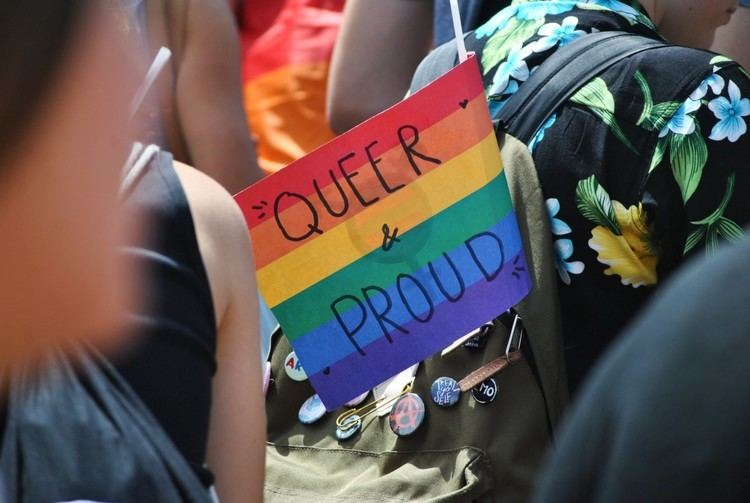 | ||
Queer heterosexuality is heterosexual practice that is controversially called queer. The concept was first discussed in the mid-1990s, critically within radical feminism, and as a positive identification by Clyde Smith in a paper delivered at a conference in Amsterdam in 1997; most papers cite these two as their entry point into the discussion. In 2003 Village Voice published an article called "The Queer Heterosexual" which has been referred to in papers published since, as it delineates the territory covered by the term.
Contents
Examples of queer heterosexuality are when one or both partners express their gender in non-traditional ways: heterosexual butch women or feminine men, and taking up different gender roles.
Feminist criticism and queer theory
Kitzinger and Wilkinson argued that the rehabilitation of heterosexuality through "'queer' heterosexuality" as "a concept derived from postmodernist and queer theory" is seen as flawed from a radical feminist perspective. Acknowledging that 'queer heterosexuality' is rarely explored in detail, they explain that "the notion of the 'queer heterosexual' had become established in queer theory", gaining currency not because people are convinced it is possible or desirable, but "because queer heterosexuality is a necessary component of 'gender-fucking'" in Butlerian terms. 'Queer heterosexuality' becomes named in the project which destabilises all such categories and moves towards a world where categories like heterosexual are rendered redundant.
In a 2004 paper, Annette Schlichter describes the discourse on queer heterosexuality as aiming at "the de- and possible reconstruction of heterosexual subjectivity through the straight authors’ aspiration to identify as queer." In the paper a genealogy of queer heterosexuality is outlined, pointing out that "the queer critique of sexual normativity is both bound to the history of specific identities and committed to the destabilization of sexual identities—including those that have become hegemonic", while "critics concerned about issues of lesbian visibility and difference occasionally raise the specter of the queer heterosexual [...] as an indication of the queer project’s perversion of social and political identities and their relations to power."
Putting to one side the question of whether the idea of homosexual contagion is necessarily homophobic, Guy Davidson uses the article from the Village Voice as an example of how the idea of queer subversion of heterosexuality can have "politically positive implications", specifically in relation to Tristan Taormino's writing on celebration of the LGBT movement's queering of heterosexual sex practices the production of the "queer heterosexual".
In Straight writ queer, the authors acknowledge that the queer heterosexual is only starting to emerge from the closet, seeking in the book to "identify and out the queer heterosexual" in historic and contemporary literature and to identify "inherently queer heterosexual practices" which critique heteronormativity and open up possibilities for the future. The examples in the book include anchorites, the Marquis de Sade and Algernon Charles Swinburne as examples of queer heterosexuals. "Male masochism disavows a masculinity predicated on phallic mastery, and hence becomes a strategic site for queer heterosexual resistance to heteronormativity".
Examination of masculinity
In 2005, Robert Heasley explored queer heterosexuality among a group of men that he identifies as "straight-queer males." According to Heasely, these men are self-identified heterosexuals who do not find social spaces dominated by traditionally masculine personalities comfortable. Heasley believes that a lack of understanding of masculinity can be addressed by creating a terminology to describe non-hegemonic masculine behavior. He lists behavior such as platonic cuddling, hand-holding and emotional openness among the ones displayed by straight-queer males.
Men who have been surveyed about their "mostly straight" behavior gave various reasons for this self-identification: some felt constrained by traditional models of gender and sexual orientation, others found men attractive. Some had a small amount of sexual interest in men but no desire for romantic same-sex relationships or intercourse, while others felt romantic but not sexual interest in other men.
Controversy
This term is somewhat controversial. Many LGBT people disapprove of the appropriation of "queer" by the heterosexual and cis individual, as it is a term which has been used as a slur towards LGBT people. Many critics of the term compare the use of "queer heterosexual" to celebrities like Madonna who practice Jewish mysticism and sample trendy ethnic fashions. Daniel Harris, author of The Rise and Fall of Gay Culture, said that people who call themselves a "queer heterosexual" "are under the impression they're doing something brave. . . . I'm a little sick that straight men would use those (terms)", while Sky Gilbert referred to Calvin Thomas as "a little heterosexual male desperately wishing to be a card-carrying member of the gay community" A review of James Franco's Straight James / Gay James says that "I can’t imagine the difficulty of being a straight, cis person who isn’t fooled by the foundational fictions of hetero- and cisnormative power structures and doesn’t wish to perpetuate them—except to say that I can’t imagine that difficulty could possibly be greater than the various violences that many queer people still face today. This might be key to the problem that persists in Franco’s claim to queerness, and what about it that rankles so many gay men: a lack of perspective." The author continues on to say that they know many people who may qualify as a queer heterosexual, but none who would use the label for themselves and none who flaunt their privilege as Franco does in his book. In a further discussion of James Franco and queer heterosexuality, says that the concept of his art as queer is ridiculous. The author of the article, Anthony Moll, says that "From the concept of the interview between his straight self and his gay selves, to his ham-handed attempt to discuss queer heterosexuality, Franco comes across as a novice queer theorist who is talking through interesting, yet ultimately incomplete, ideas".
